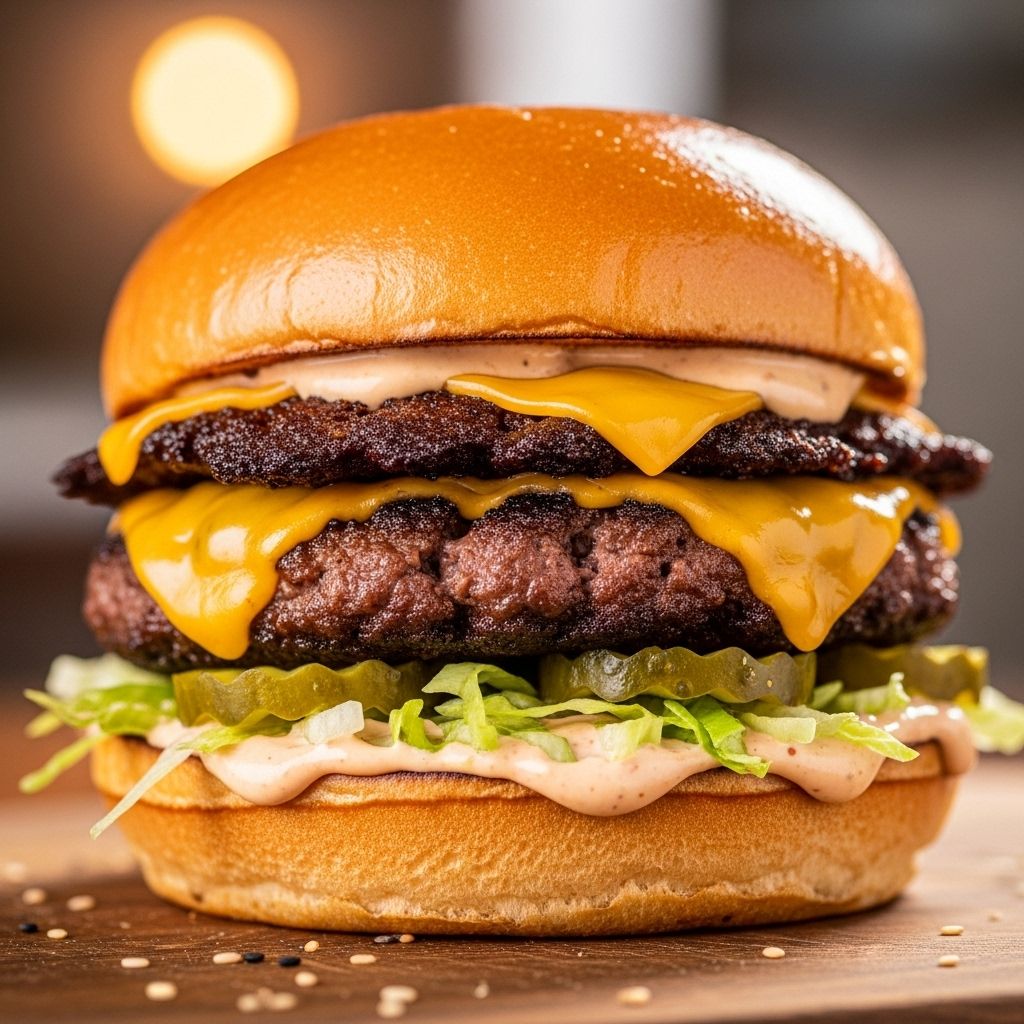Ultra-Smashed Cheeseburger: 10 Steps To Crisp, Juicy Results
Precise pressing unveils a restaurant-worthy crust and deep flavor in every bite.

The Ultimate Ultra-Smashed Cheeseburger: Technique, Science, and Flavor
Among the pantheon of classic American food, few items capture the imagination—or the appetite—like the cheeseburger. But not all burgers are created equal. The ultra-smashed cheeseburger, a staple of roadside diners and beloved by burger aficionados, is fast becoming an icon of its own. This guide unpacks the science, art, and technique behind making an ultra-smashed cheeseburger that is crisp-edged, deeply savory, and impossibly juicy. Inspired by the meticulous work of The Food Lab and the rigorous culinary exploration at Serious Eats, let’s break down the process step-by-step, so you can recreate this revelatory burger at home.
Why Smash? The Science of Searing
Conventional wisdom long held that pressing or smashing a burger patty while cooking would force out its precious juices, leading to a dry, tough result. But when performed at the right time and with the right technique, smashing unlocks burger nirvana by maximizing the Maillard reaction and creating a stunningly crisp crust.
- Smashing as soon as it hits the pan, while the meat is still cold and unrendered, preserves internal moisture. There are no juices to lose yet—only the raw components of great flavor.
- The thin patty from smashing dramatically increases its contact with the hot cooking surface, encouraging rapid browning for that sought-after “lacey,” crispy edge.
- The Maillard reaction—responsible for roasted, savory, and nutty notes—intensifies due to the broad, flat interface with the pan.
- Result: a burger that’s ultra-crisp on the outside, yet tender and juicy on the inside, without the guesswork of perfect doneness. The magic happens in mere moments.
The Burger Myth Debunked: When to Smash and Why
One of the most persistent myths in burger-making is the belief that “never smash your patty or you’ll lose all the juices.” This holds only if you smash a burger after it’s started to cook through, when juices have formed and could be forced out. The real trick is to smash immediately after the beef hits the scorching-hot skillet. Here’s why:
- At the start, the beef hasn’t yet started releasing juices—smashed now, nothing lost, except more of the patty gets direct searing.
- Once moisture begins to seep out (usually after the first minute or two), do not smash again. This is where most cooks go wrong.
- Proper smashing is an act of confidence—quick, firm, and performed only once per patty for best results.
Choosing the Best Beef for Smashed Burgers
While gourmet burger trends have waxed and waned—grinding your own beef, adding brisket or short rib, and so on—the ultra-smashed burger embraces accessibility and quality ground chuck. Here’s what you need to know:
- Beef blend: Look for ground chuck with at least 20% fat (preferably 25%) to ensure juiciness and intense flavor. Skip expensive blends or home grinding—the classic smashed burger is all about simplicity and technique .
- Buying pre-ground: There’s no need to grind brisket, add egg yolk, or alter the beef. Freshly ground is ideal but not mandatory for this method.
- Patty size: Use 4 ounces of beef, divided into two 2-ounce balls. Smaller balls allow for ultra-thin, crisp patties that stack perfectly within a standard bun.
Ingredients for the Ultimate Smashed Cheeseburger
| Ingredient | Details |
|---|---|
| Ground chuck | 4 ounces (two 2-ounce balls), at least 20% fat |
| Burger buns | 1 soft, classic hamburger roll, buttered and toasted |
| Cheese | 1 slice of good melting cheese (American or similar) |
| Salt & black pepper | To taste, for seasoning patties |
| Condiments & toppings | As desired: mayonnaise, mustard, shredded lettuce, onions, tomatoes, pickles, etc. |
Essential Equipment
- Cast iron skillet or griddle: Heavy-bottomed and able to retain high heat without warping—essential for crisping.
- Sturdy spatula: Preferably a thin, sharp-edged metal spatula for maximum smashing power and clean patty lifting.
- Bench scraper (optional): Useful for lifting ultra-thin, crispy patties.
- Butter knife or pastry brush: For buttering buns before toasting.
The Step-By-Step Ultra-Smashed Burger Method
- Prep the Buns: Butter and toast the cut sides of your hamburger roll until golden brown. Set aside.
- Shape the Beef: Take 4 ounces of ground chuck and divide it into two 2-ounce balls. Keep them chilled until ready to cook.
- Preheat Surface: Heat a cast iron skillet or griddle over high heat until it’s nearly smoking. No need to oil the pan—the beef’s fat will do the work.
- Smash the Patties: Place a beef ball onto the hot surface. Immediately press it down firmly with the spatula (or spatula + bench scraper for extra leverage) until it’s thin—just under ¼ inch. Repeat with the second ball, providing a little space between.
- Season Generously: While the patties sizzle, immediately sprinkle each with kosher salt and black pepper.
- Don’t Move the Patties: Let them sear undisturbed for about 60 to 90 seconds. Do not press again. This maximizes crust development and prevents loss of moisture.
- Scrape and Flip: Use a sharp-edged spatula to scrape the patties up and flip. You want to get under the crisp crust without tearing it.
- Add Cheese: As soon as you flip, add a slice of cheese to one patty. Stack the second patty on top of the cheese-covered one to form a double layer.
- Steam and Melt Cheese (Optional): Cover briefly or add a touch of water beside the patties to melt the cheese quickly, if you prefer a gooier texture.
- Build the Burger: Place your desired condiments and toppings on the toasted bottom bun, then gently place the stacked double patty on top. Cap with the top bun and serve immediately.
Key Tips for Smashed Burger Success
- High heat is critical: Ultra-thin patties cook in seconds, so the pan must be extremely hot to form a crisp crust quickly before overcooking.
- Smash early, smash once: Only smash within 30 seconds of the beef hitting the pan. Repeated smashing after juices have formed will dry out the patty.
- No binders, no fuss: Skip egg yolk, breadcrumbs, or gelatin. Ground beef alone is all you need for maximum flavor and texture.
- Fast assembly: Once cooked, stack, bun, and serve immediately. Smashed burgers are best enjoyed hot and fresh.
Classic Toppings and Variations
The ultra-smashed cheeseburger celebrates simplicity, but the right toppings and condiments elevate the eating experience. Here are traditional choices and creative twists:
- American cheese: Melts perfectly and delivers classic burger flavor.
- Shredded lettuce and sliced onions: Offer a crisp, refreshing counterpoint to the rich patties.
- Pickles and tomatoes: Essential for tang and juiciness.
- Condiments: Try ketchup, yellow mustard, mayonnaise, Thousand Island-style sauce, or zesty burger sauce. Feel free to craft your own blend.
Other variations include grilled or caramelized onions, bacon, or swapping the cheese for sharp cheddar or pepper jack. The only rule: don’t overload—let the crispy double patty be the star.
Expert Troubleshooting: Common Mistakes and Solutions
- Problem: Burger sticks to the pan.
- Solution: Make sure the pan is extremely hot before adding the beef. Use a sharp metal spatula for scraping up the patty, ensuring you get all the crispy bits.
- Problem: Patty is dry or tough.
- Solution: Only smash at the start, use high-fat beef, and avoid pressing after juices have formed.
- Problem: Cheese doesn’t melt fully.
- Solution: Cover the pan briefly or flick a tablespoon of water to create steam for thorough melting.
- Problem: Bun falls apart.
- Solution: Use classic soft hamburger buns, and always butter and toast them until well-browned for stability and flavor.
Nutritional Perspective: Why This Burger Works
The ultra-smashed cheeseburger isn’t just about indulgence—it’s about maximizing flavor with minimalist, high-quality ingredients and sound cooking science:
- Using high-fat beef keeps the patties moist without excessive thickness or elaborate binders.
- The rapid, high-heat cooking forms an unbeatable textured crust while sealing in beefy flavor.
- Stacking thin patties with cheese ensures every bite delivers full bun-to-patty-to-topping harmony, instead of the “meatball-in-a-bun” syndrome.
- Keeping the ingredient list short, each element’s flavor and texture stands out.
Comparison: Ultra-Smashed vs. Other Smash Burgers
| Feature | Classic Smashed | Ultra-Smashed (Food Lab) |
|---|---|---|
| Meat portion | Usually one thicker patty | Two ultra-thin patties stacked |
| Fat content | 18-20% (varies) | 20-25% ground chuck |
| Cooking method | Occasional smashing or pressing | Immediate, single hard smash |
| Crust formation | Good but not always maximized | Extensive, deeply browned crust |
| Juiciness | High if cooked correctly | Very high due to technique |
| Stacking | Single or double | Always double for optimal cheese melding |
Frequently Asked Questions (FAQ)
Q: What’s the best pan for making ultra-smashed burgers?
A: Cast iron skillets or griddles work best due to their heat retention and ability to develop a serious crust. Avoid nonstick pans, which generally can’t get hot enough for proper searing.
Q: Can I use other cheeses besides American?
A: Absolutely. While American cheese is classic for its lovely melt and classic burger-shop flavor, feel free to substitute with cheddar, Swiss, or pepper jack depending on your preferences. Softer cheeses melt best.
Q: Do I need to grind my own beef for ultra-smashed burgers?
A: No. The Food Lab’s method specifically calls for good-quality pre-ground chuck with at least 20% fat, no special blends or home-grinding required. Fresh is best, but smashing technique matters more than the beef grind for this style.
Q: Why make two patties instead of one thicker one?
A: Two thinner patties maximize surface area for crust formation, tightly sandwich melted cheese, and yield a superior beef-to-bun ratio in every bite. One thick patty doesn’t achieve the same crust or texture contrast.
Q: Can I make a vegetarian version?
A: The crispy, lacy crust of the ultra-smashed burger is difficult to replicate with plant-based meat analogs, but some high-fat veggie burger formulations can be smashed with decent results. Stick to high-protein, high-fat plant mixtures for best texture.
Extra Burger Hacks and Tips
- Shape beef balls gently—don’t overwork or compact, which can toughen patties.
- If making multiple burgers, work in batches and pre-toast all buns in advance.
- Don’t let smashed burgers rest—eat immediately for maximal juiciness and crispness.
- Experiment with a thin smear of mustard directly onto the patty before flipping—this creates a tangy, caramelized “mustard sear.”
- For the ultimate classic pairing, serve with crispy shoestring fries and an ice-cold soda.
Conclusion: Beyond the Burger Myth
The ultra-smashed cheeseburger represents the best of American fast-food tradition—it’s simple, nostalgic, and undeniably delicious. By embracing science, precise technique, and high-quality fat-rich beef, you can produce burgers bursting with beefy flavor and crisp texture—ready in minutes, without the need for special equipment or gourmet ingredients. The only real challenge? Resisting the urge to make a second (or third) as soon as you finish the first.
References
Read full bio of Srija Burman












